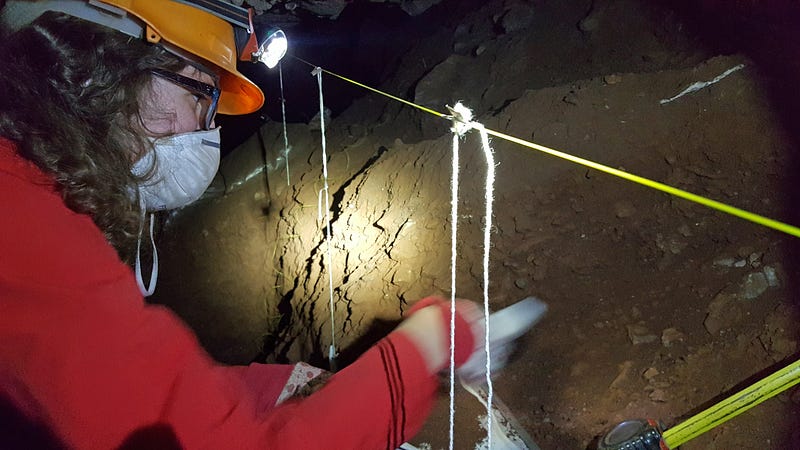
By Ben Zastrow
From ancient history to the distant future, from The Flintstones to Star Wars, we have always been a species fascinated with both how we got here and where we will be years from today. It is a topic with a constantly expanding base of knowledge, which covers a wide variety of disciplines including anthropology, genetics, science fiction, and many others. Three years ago, two amateur cavers in South Africa made the initial discovery of the bones of a new species of hominid, Homo naledi. This extinct ancestor not only provides new insight into how we became modern Homo sapiens, but also helps guide our understanding of how our species will continue to evolve and adapt.
The cavers were exploring the Rising Star Cave System, a popular series of caverns and tunnels near Johannesburg, when they stumbled upon a narrow passage that led to a new chamber with a veritable treasure trove of fossils. Soon after, Dr. John Hawks, a UW–Madison paleoanthropologist, was on his way there to help with the excavation. As the fossils were excavated and examined, the team of scientists discovered an unusual contrast of characteristics. “Their hands are good at manipulating and making tools… their skulls are shaped in many ways like a human skull, they have small teeth that seem to indicate a higher diet quality,” explains Hawks, “but they have traits that are related to climbing, and they have a very small brain. They have that mixture of features that really puts them at the very beginning point or base of our genus, potentially.”
Additional evidence of this contrast can be found in the strange manner in which the bodies were discovered. The isolation of the cave and the large quantity of bodies seemed to suggest that these beings, which became known as the Naledi, might have been deliberately depositing their dead. This is a behavior that traditionally is associated with large brained, more modern species such as Neanderthals and humans. “If this all pans out, what Naledi tells you, maybe more than anything, is that the ways that we think intelligence is important to our evolution didn’t all require a larger brain,” says Hawks. “We have large brains as humans today, maybe that means something different than what we expected . . . It’s showing that the way that we became human was more oriented towards what we were doing with our hands, how we were moving on the landscape, and less oriented towards larger brains.”
Studying the ways that these kinds of traits come about helps scientists to make predictions about the effects evolution will have on our future. “We’re trying to understand where people come from,” explains Hawks, “and our work is to understand how we were different in the past and what has caused us to become the humans that we are today.” Gaining this understanding of our past leads directly to an understanding of what the future may hold. The importance of this ability to predict how such changes take place cannot be overstated, as it is inextricably linked to every aspect of human life.
Species have always undergone natural evolution due to changes in their surroundings. For humans this will only be accelerated due to the increasing pervasiveness of technology in every facet of life. One effect of this that can already be seen is how humans are more globally connected now than ever before. It is not uncommon nowadays for someone to be able to trace their recent ancestry to origins on multiple continents, creating totally new genetic combinations. This level of exposure to genetic diversity would never have been possible for the Naledi or similar extinct hominid species, whose remains typically are found only in very specific regions of the world, often only at one or two different sites. However, global connectivity is a double-edged sword as it also is slowly creating homogeneity in our species. “We have lost hundreds, maybe thousands of cultures in the last 100 years,” says Hawks. “We are becoming more uniform behaviorally, culturally, linguistically, and in biological terms our populations are mixing at a faster rate than ever before.”
That being said, the natural course of evolution the Naledi sheds light on is no longer the only way species can evolve. Genetic manipulation to preselect certain traits in future offspring is already an existing field of study. Many researchers such as Hawks assert that this will soon be an option for the general public, citing the commonplace industrial manipulation of genes in crops, livestock, and garden plants. It can be assumed that this so-called “artificial evolution” will soon take advantage of such methods. Accelerating and altering natural selection in this manner will likely work to eliminate harmful human traits and maybe even introduce new, desirable ones that would not otherwise have existed.
Of course, changes such as these occur over a long period of time. As this process takes place, we can continue to search for clues to better understand our own story. Homo naledi fills in some pieces of the human evolution puzzle, but it’s just not yet clear which pieces — only further studies will reveal the answer. The influences of the past can be seen in modern humans, and the future of humanity is similarly dependent on the environments we live in now. Exciting changes are on the way and technology is ushering in a new age of human advancement that will shape the course of our species forever.
